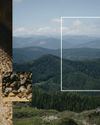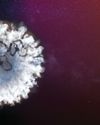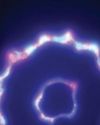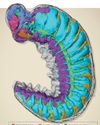
Gathered in a common room, the mourners G say goodbye to the body of their pioneering geologist, dead from a brain aneurysm. The Mars base memorial service remembers a fellow colonist, but also celebrates a milestone for humanity: On June 23, 2034, she became the first person to die of natural causes on Mars.
After the service, while the mourners head to the public grove that serves as a graveless cemetery, a pair of technicians undress the body and move it to a room ringed with stainless-steel pods. These are tissue digesters. The techs transfer the body into an empty pod and seal the lid. Soon it fills with water spiked with potassium hydroxide, a caustic base. Then the pod is heated to 300° Fahrenheit and pressurized to 70 psi.
After about 12 hours of pressure-cooking alkaline hydrolysis, the pod drains with an automated whoosh, leaving only the bones. The broth is piped to the colony's anaerobic digester, where microorganisms break down biodegradable waste to produce methane gas that will fuel spacecraft and other vehicles. The remaining liquid becomes fertilizer along with the bones, which are heat-dried and crushed into a nitrogen- and mineral-rich powder. Nitrogen is a key component of chlorophyll, making this a valuable addition to the fertilizer used to grow Martian crops. Any remaining solids are transferred to compost bins to eventually form building materials like walls, deck planks, and particle boards. Every molecule is reused. There are no landfills on Mars.
Dying on Mars means living on Mars, and that our species has mastered the dangers the Red Planet poses. The hazards-the journey through space, treacherous landing, and brutal realities of life on an alien planet-are formidable. And the longer people stay on Mars, the greater the challenges grow.
この記事は Popular Mechanics US の May - June 2023 版に掲載されています。
7 日間の Magzter GOLD 無料トライアルを開始して、何千もの厳選されたプレミアム ストーリー、9,000 以上の雑誌や新聞にアクセスしてください。
すでに購読者です ? サインイン
この記事は Popular Mechanics US の May - June 2023 版に掲載されています。
7 日間の Magzter GOLD 無料トライアルを開始して、何千もの厳選されたプレミアム ストーリー、9,000 以上の雑誌や新聞にアクセスしてください。
すでに購読者です? サインイン

ONE OF THE 'GREATEST THREATS' TO THE PACIFIC NORTHWEST ISN'T WHAT YOU THINK.
EXPERTS ARE PREPARING THE REGION AGAINST THE THREAT OF DANGEROUS VOLCANIC MUDFLOWS, KNOWN AS LAHARS, WHICH COULD INUNDATE THE COMMUNITIES SURROUNDING MT. RAINIER IN AS LITTLE AS 30 MINUTES.

THE WORLD'S TOUGHEST ROW
They rowed 3,000 miles across the Atlantic, battling unpredictable weather, chaotic seas, and finicky equipment. But what they discovered gave them profound new insights into the power of the ocean.

HOW TO DIY OFF-GRID SOLAR
SPEND THE TIME UP FRONT AND PLAN IT CAREFULLY TO AVOID DISAPPOINTMENT

Are We on the Verge of an ARMS RACE in SPACE?
RUMORS OF A RUSSIAN SPACE NUKE, ALONG WITH OTHER SATELLITE-TARGETING WEAPONS, HAVE MADE GEOPOLITICAL TENSIONS EXTEND INTO ORBIT.

Fresh Fingerprints on an Ancient Statue
A CLAY FIGURINE HAS SPENT MILLENNIA incomplete, waiting at the bottom of a lake for its long-dead craftsman to finish the Iron Age-era statuette.

Quantum Entanglement in Our Brains
IT HAS LONG BEEN ARGUED THAT THE human brain is similar to a computer. But in reality, that's selling the brain pretty short.

The Tools of Copernicus
WAY BACK IN 1508, WITH ONLY LIMited tools at his disposal, Nicolaus Copernicus developed a celestial model of a heliocentric planetary system, which he described in hist landmark work De revolutionibus orbium coelestium. It was a complete overhaul of our conception of the universe-one that, unfortunately, earned him the ire of the Catholic church for decades after his death-and forever changed the way we look at the stars.

Building a Sixth-Generation Bomber Raptor
THE GLOBAL COMBAT AIR Programme (GCAP)-a project by the U.K., Italy, and Japan to develop a sixth-generation stealth fighter-has been busy at the drawing board reshaping its vision of the future of air warfare. And judging by the new concept model unveiled at this year's Farnborough air show, that future has big triangular wings.

The Electroweak Force of the Early Universe
TODAY, THE UNIVERSE AS WE KNOW IT IS governed by four fundamental forces: the strong nuclear force, the weak nuclear force, electromagnetism, and gravity.

This Ancient Fossil With a Brain and Guts
WE KNOW WHAT FOSSILS LOOK like. For example, typical dinosaur fossils are bones turned to stone and preserved from the passage of time, located, if we're particularly lucky, in large collections that can be reassembled to represent the beast they used to prop up in their entirety.